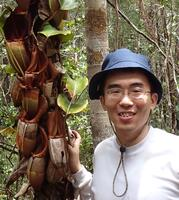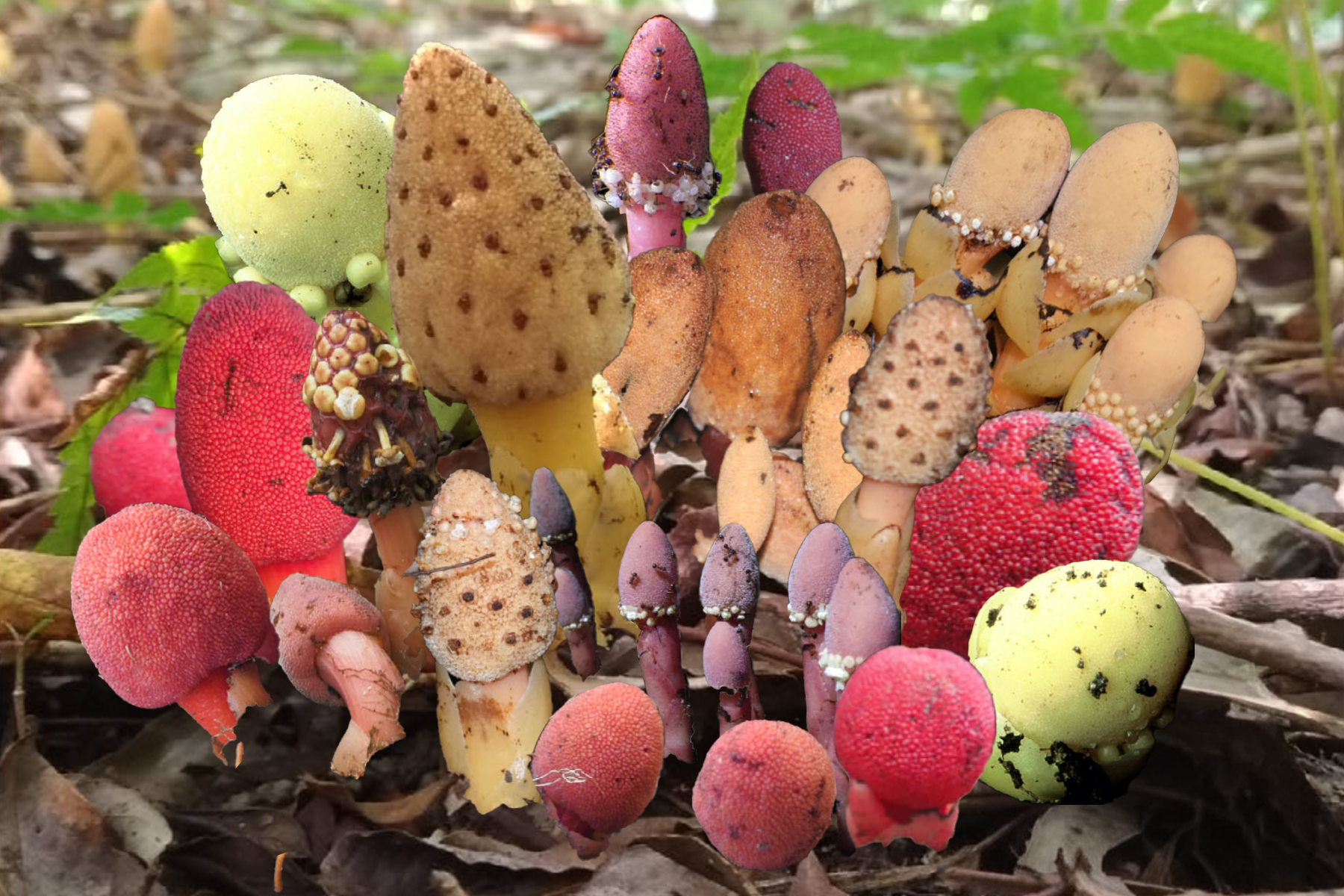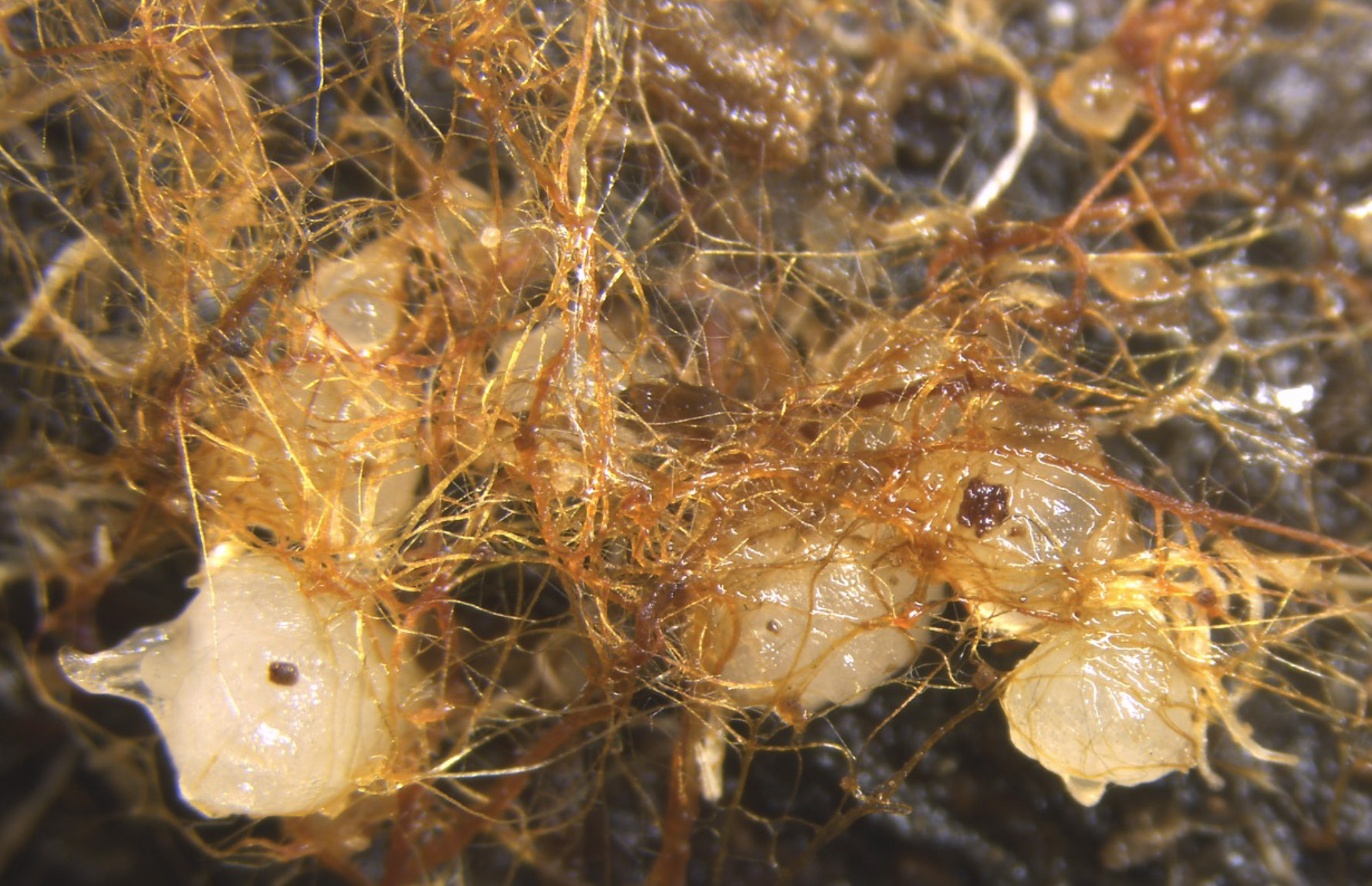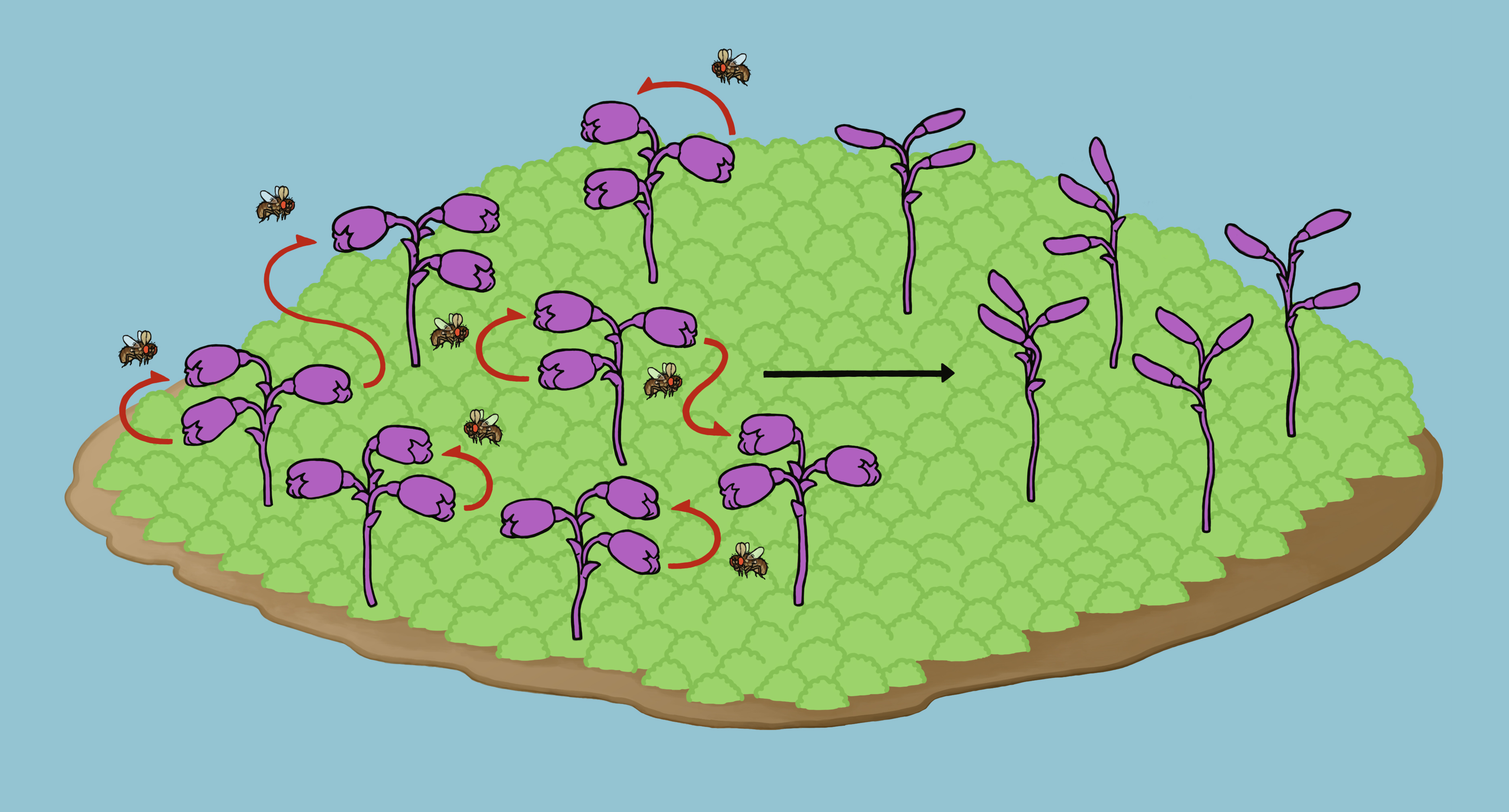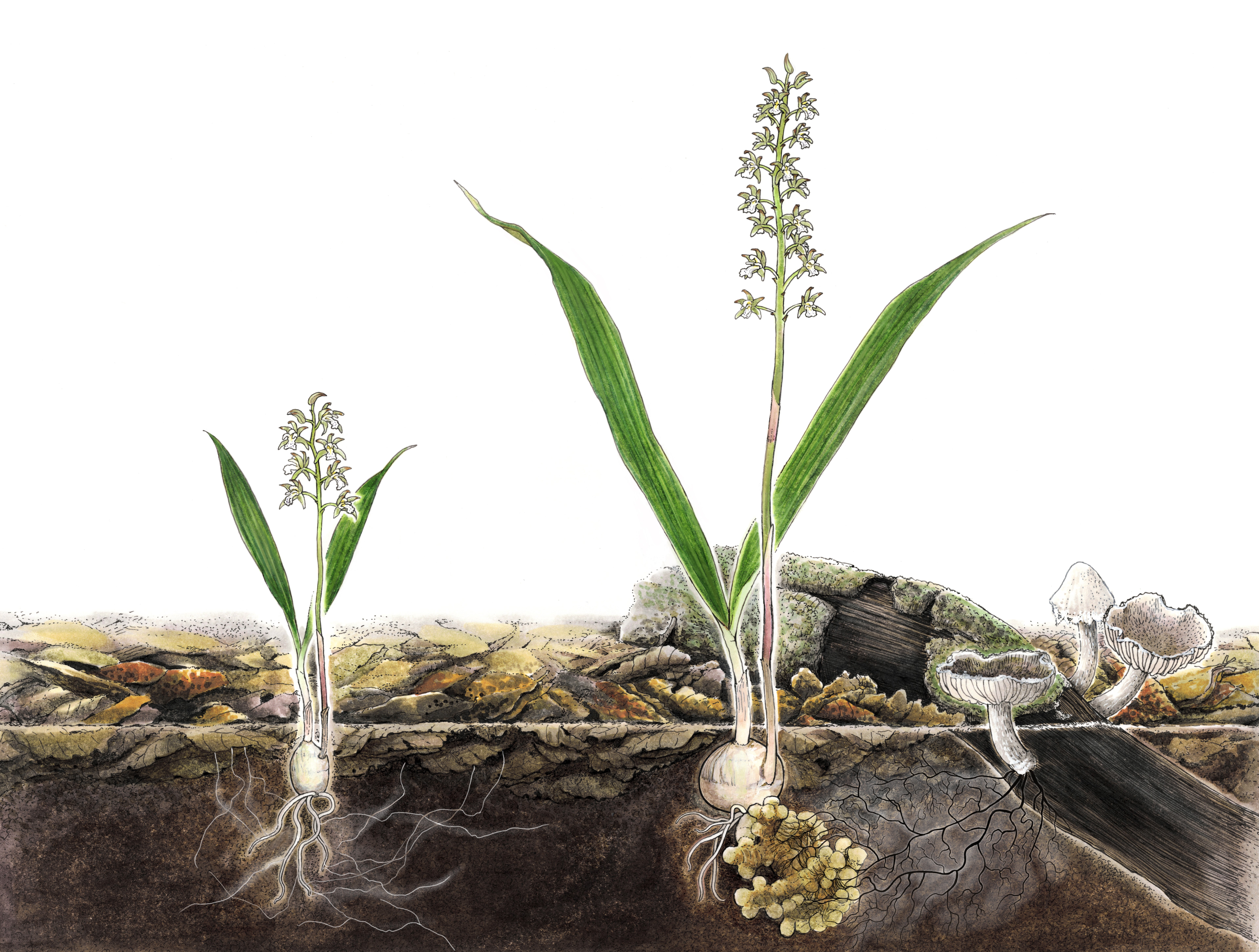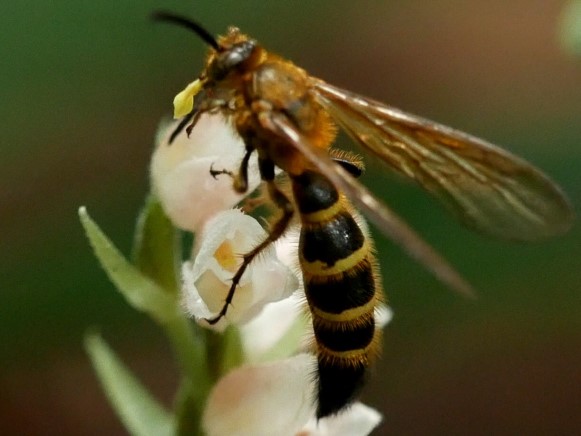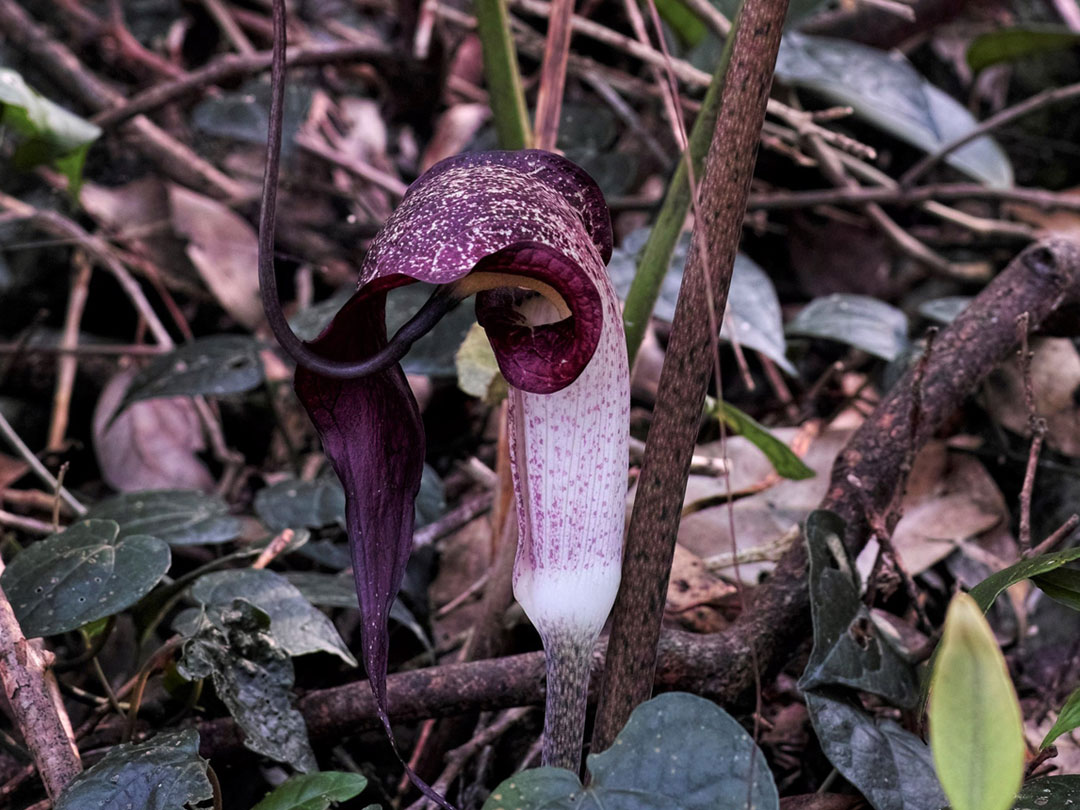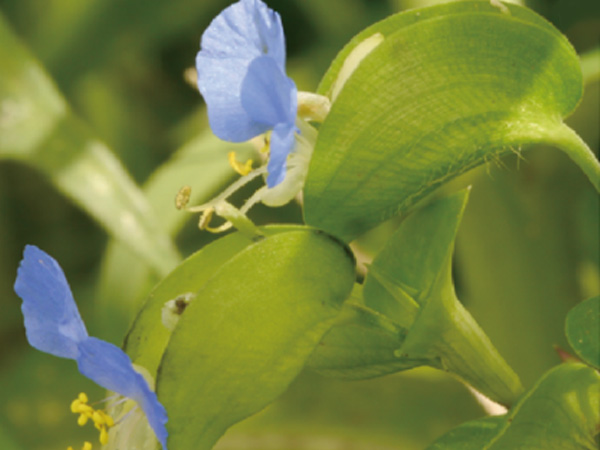The distinctive-looking plant Arisaema urashima is a common sight in woodlands in Japan. It has a large spathe (sheath enclosing its flowers) from which hangs a long-thread like appendix (that can reach over 50cm in length) that looks like a fishing rod and line. Its unusual shape was thought to resemble the Japanese folktale character Urashima Taro fishing, hence the plant’s name. However, the functional significance of this thread appendage has remained unknown for many years.
A research collaboration (including Associate Professor SUETSUGU Kenji and graduate student Mr. NISHIGAKI Hiroki of Kobe University’s Graduate School of Science) has spent 3 years conducting field experiments to determine what role this thread plays in attracting pollinators. Conducting experiments where the plant’s characteristic thread was removed revealed that this affected the plant’s ability to attract fungus gnats, which are believed to be its primary pollinators, however, attraction of other insect species was not impacted by the removal. In addition, the flower’s production of fruits (fruiting rate) was significantly reduced if the thread was removed. In other words, as the imagery surrounding the plant suggests, Arisaema urashima’s ‘fishing rod’ selectively reels in the primary pollinator, increasing the plant’s reproductive success.
This research was published online in the international journal Ecology on June 28.
Research Background
The majority of plants rely on animals such as bees to help them pollinate; when the insect transports pollen between flowers, it receives a reward (nectar etc.). However, even what appears to be a harmonious relationship between two species at first glance is the result of a mutually exploitive strategy. In other words, the partners in a mutualistic relationship are not altruistic and both simply take actions that promote their own best interests. Therefore, mutualistic relationships also provide a window for exploitation by parasitic species that can acquire a resource without providing anything in return. For example, there are plants with beautiful flowers that appear to carry nectar but in reality they exist to deceive insects into transporting their pollen. Of the many plants that habitually exploit their insect pollinators in this way, the Arisaema genus of plants adopts the most cunning strategy. Upon seeing Arisaema’s water pitcher-like shape, many people may think it is a carnivorous plant (Figure 1). Even though this is not the case, the similar shape is not a coincidence. Both carnivorous plants and Arisaema have evolved into this shape because of their shared characteristic; they both imprison the insects that they lure in.
Let’s look in more detail at why plants of the Arisaema genus trap the pollinators that they have attracted. Both male and female Arisaema plants have a structure called a spathe, which encloses their many flowers (Figure 1). A cylindrical organ called the spadix emits a scent which attracts pollinators (mainly fungus gnats), causing them to enter through the opening at the top of the spathe. However, the inside of the spathe is coated with a slippery wax, making it impossible for the gnat to get back out through the top. Despite this, the structure of the male plant allows the gnat to escape. As it wanders between the flowers at the bottom of the spathe, the gnat gets pollen on its body and eventually finds the small holes in the bottom that enable it to get back outside. On the other hand, the female plant has no such exits. Once inside the female plant, the gnat gets the pollen it has delivered all over the flowers as it struggles inside the flower cluster (inflorescence) to find a way to escape and eventually dies (Figure 1).
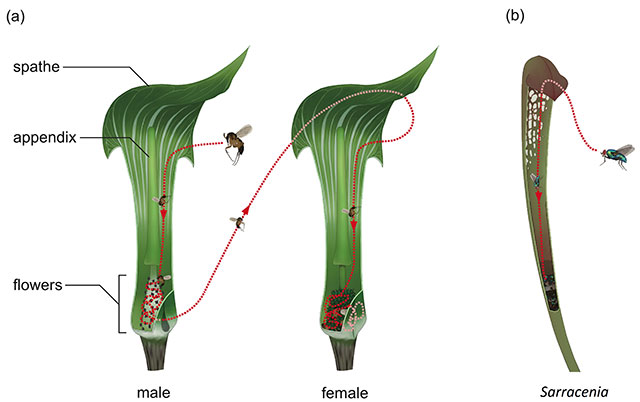
Both plants have evolved into a similar shape due to the same evolutionary pressure to trap insects, although their aims in trapping them differ (Arisaema: reliable pollination; Sarracenia: nutrient absorption).
Another exciting aspect of this plant genus is that some Arisaema species have a thread-like structure that protrudes from the tip of the spadix. Arisaema urashima is an excellent example of this as it has an appendage over 50cm long that protrudes from the spathe and hangs down, resembling a fishing rod. It got its name because the plant’s shape resembles the Japanese folktale character Urashima Taro fishing (Figure 2). In addition, numerous plants beyond the Arisaema genus are known to have a similar thread-like appendage, including unrelated plants that are also pollinated in the same way by flies (e.g. the Aristolochia genus). However, there has been little investigation into the effect of this distinctive appendage on pollinator behavior and it has been a topic of debate for over 100 years.
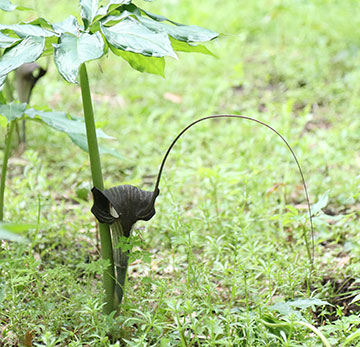
The plant’s name originates from its resemblance to Japanese folktale character Urashima Taro’s fishing rod. (Photo credit: Kato Emiko)
Detailed Explanation of Research
Seeking to reveal whether or not Arisaema urashima’s thread is attractive to pollinators, a research group formed consisting of Associate Professor Suetsugu, Mr. Nishigaki, Mr. FUKUSHIMA Shigeki (Researcher at Chiba Prefectural Agriculture and Forestry Research Center), Mr. ISHITANI Eiji (former researcher at the aforementioned research center), Dr. KAKISHIMA Satoshi (Part-time specialist researcher at the National Museum of Nature and Science), and Dr. SUEYOSHI Masahiro (researcher at the Forestry and Forest Products Research Institute).
In 2019 and 2020, they conducted field experiments where they removed different portions of the thread-like appendage from Arisaema urashima plants just before they flowered. The groups were divided as follows: ‘Thread-removal’ where they left a portion of appendage so that it resembled that of other typical Arisaema species, ‘Complete Removal’ where the entire appendage was removed, and ‘Intact’, an unmanipulated control group (Note 1). After the flowering period had ended, the researchers examined the number and species of insect individuals trapped inside the inflorescence of plants in each of the groups. The results revealed that merely removing the thread-like part dramatically decreased the number of Mycetophila fungus gnat visitors, which has been considered the plant’s primary pollinator (Figure 3). On the other hand, there was no change in the frequency of visits from other insect species when the thread-like part was removed. However, completely removing the appendix, including the swollen basal portion that emits scent, did result in a decreased rate of flower visits overall (Figure 3).
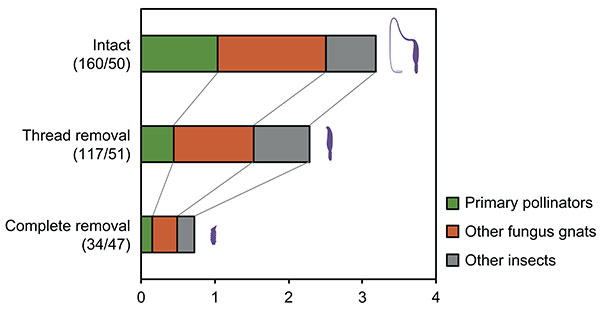
Only visits by Mycetophila individuals (the main pollinator) were reduced when the rod was removed. Indicated in brackets is the total number of trapped insects/total number of Arisaema urashima plants.
As it was revealed that the thread attracts the insects considered to be the primary pollinators, the researchers conducted a subsequent experiment in 2021 where they left unmanipulated female plants and female plants with the thread removed alone until the fruits reached maturity to see if any difference in the fruit percentage could be observed. The results showed that merely removing the thread dramatically decreased the fruit set. Yet again, removing the thread did not reduce the frequency of other insect visitors but rather the decline in the number of fungus gnat visitors specifically affected the plant’s reproductive success.
To summarize, the results of this experiment provide evidence for fungus gnats being Arisaema urashima’s primary pollinator. Looking at both experiments together, we can say that the function of Arisaema urashima’s ‘fishing rod’ is to selectively reel in the primary pollinator, increasing the plant’s reproductive success (Figure 4). In the future, the researchers hope to investigate the functional significance of similar thread-like appendages in many other fly-pollinated plant species.
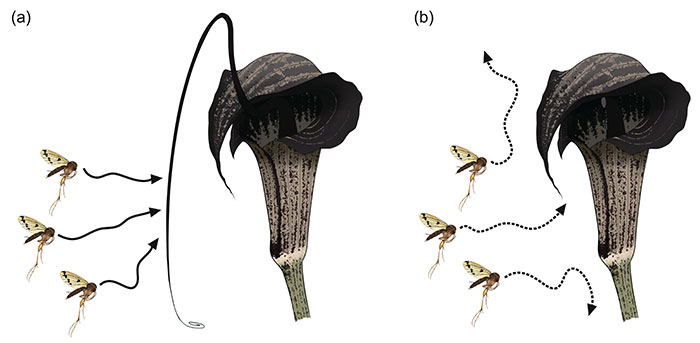
As the imagery surrounding the plant suggests, Arisaema urashima’s ‘fishing rod’ selectively reels in the main pollinator.
Note
1. In order to count up the total number of insects trapped by Arisaema urashima, the exit holes of all the male inflorescences were plugged with cotton wool to prevent them from escaping through the holes in the bottom.
Journal Information
- Title
- “Thread-like appendix on Arisaema urashima (Araceae) attracts fungus gnat pollinators”
- DOI
- 10.1002/ecy.3782
- Authors
- Kenji Suetsugu, Hiroki Nishigaki, Shigeki Fukushima, Eiji Ishitani, Satoshi Kakishima, and Masahiro Sueyoshi
- Journal
- Ecology

